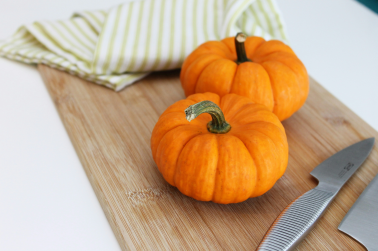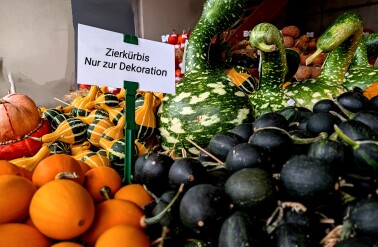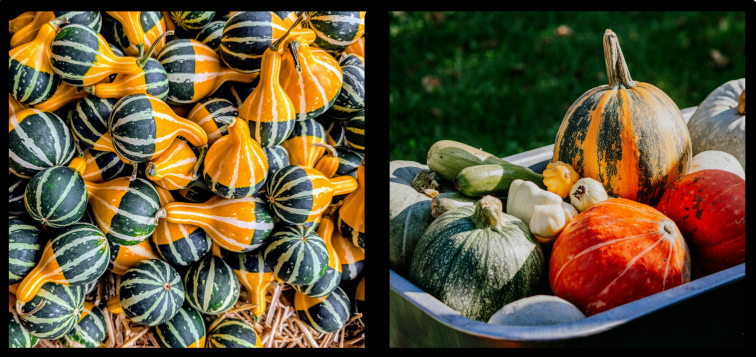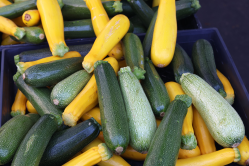In the summer and autumn months, Tox Info Suisse receives more frequent enquiries about bitter pumpkins and courgettes. Some people instantly notice the bitter taste of the pumpkin dish and only try a small amount. Others continue to eat the entire courgette from their neighbour’s garden despite the bitter flavour. Later, plagued by stomach cramps and diarrhoea, they remember the bitter taste. “Poisonous pumpkins” and “killer courgettes” – what’s behind these horror stories?
The bitter aftertaste of «poisonous pumpkins» and «killer courgettes»

Was the bitter squash on your plate really safe to eat?
Toxic ornamental pumpkins, edible squash
Have you ever wondered why you see ornamental pumpkins labelled as «only for decoration» or «not for consumption»?
The reason for this is the cucurbitacins, the toxic bitter substances that ornamental squashes contain. These substances protect the cucurbits (the gourd family) from predators such as insect larvae. Edible squash have been cultivated to largely eliminate cucurbitacins. This is why raw edible pumpkins have a pleasantly mild taste, sometimes slightly nutty or neutral – but never bitter.
No amount of washing or cooking helps against cucurbitacins
Cucurbitacins are heat resistant, which means that they do not break down or evaporate during cooking. They also cannot be washed away as the substances are inside the plant. However, adding spices or sugar can cover up the bitter taste, which is why it is important to taste squash and courgettes raw, before you prepare them.
Why are edible pumpkins or courgettes sometimes bitter?
Other edible cucurbits (Cucurbitaceae) such as courgettes and cucumbers have also been cultivated to largely eliminate cucurbitacins from the fruit.* But sometimes the bitter taste comes back – even in melons, which are also part of the cucurbit family.
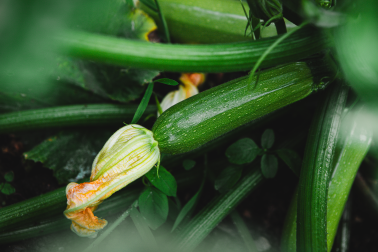
Cross-pollination with ornamental squash
This can happen if an edible squash cross-pollinates with an ornamental squash. Cucurbits are cross-pollinators and are often pollinated by insects. The newly evolved squashes look like a normal edible squash but they contain poisonous cucurbitacins. You only notice that something isn’t right when you eat them and taste bitterness. Cross-pollination can also occur similarly between ornamental squashes and courgettes, once again producing poisonous cucurbitacins.
Cucurbitacin production under stress conditions
It appears that there is a certain residual capacity for edible squashes and courgettes to form cucurbitacins and this residual capacity is triggered, for example, when the plants are stressed. In this scenario, the almost completely reduced production of bitter substances can be reactivated. Dry, extremely hot weather, strong temperature fluctuations, overripe vegetables and incorrect storage can lead to increased levels of cucurbitacins.
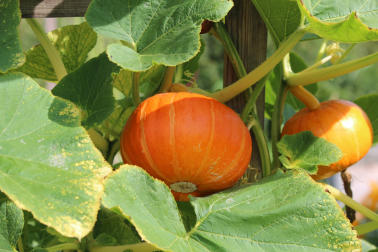
What should you do when you taste bitterness?
If you notice a bitter taste when eating courgettes, squashes, cucumbers or melons, stop eating them immediately! Trust your senses.
Even if you’re eating a lovely large courgette from your own garden or a pumpkin that you were given by your mother – in this case bitter means danger.
What do I need to worry about if I have eaten bitter tasting squash?
If you’ve eaten something despite the bitter taste, there isn’t a lot you can do other than wait and see whether you will get symptoms such as nausea, vomiting or diarrhoea. Tox Info Suisse advises against intentionally inducing vomiting. Symptoms generally occur within a few hours and do not usually last long. Bitterness does not necessarily mean that you will get symptoms.
Tox Info Suisse has not recorded any fatalities in connection with cucurbits to date. A French study, in which a total of 353 cases from 2012 to 2016 were investigated, also did not find any serious outcomes or fatalities (Le Roux G, 2018). However, a tragic case in Germany showed that in extremely rare cases, there may be serious consequences. A 79-year-old man died in 2015 after consuming a bitter courgette from his own garden and suffering complications from severe gastrointestinal symptoms. His wife, who had eaten a smaller amount, recovered after brief treatment.
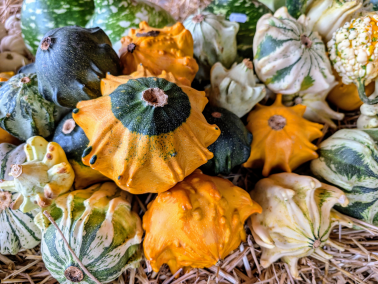
What should you do in the event of symptoms?

There is no specific therapy. Treat the symptoms like a normal gastrointestinal disorder: Drink lots of fluids. However, if you experience bloody diarrhoea or persistent and severe pains, seek medical assistance.
A rapid and substantial loss of fluids as a result of prolonged vomiting and diarrhoea is dangerous, especially for children, the elderly or those weakened by illness.
If you have any questions or uncertainty, do not hesitate and contact Tox Info Suisse!

What’s the moral of this scary story?
Save the «poisonous pumpkins» and «killer courgettes» for your Halloween decorations.
Prevention – avoid bitter surprises
- If your courgette, squash, cucumber or melon tastes bitter, stop eating it immediately!
- Always try courgettes, squashes and cucumbers raw before preparing them.
- Ornamental squashes are truly only intended for decoration – do not eat!
- Avoid plant proximity:
Do not grow courgettes, squashes and cucumber plants together with ornamental squashes in the same bed, to avoid cross-pollination which could produce poisonous bitter substances (cucurbitacins). Keep plants a good distance apart and use fresh seeds every year to err on the side of caution.
Further information
Perception of bitterness:

The perception of bitterness is the subject of in-depth research and we are continuously learning more. Simply put, a substance is described as a bitter substance if it tastes bitter on the tongue. This is a result of one or more of the tongue’s T2 bitter receptors activating. However, a single bitter receptor in a specific place isn’t the only way we perceive a bitter taste. We have other bitter receptors spread around our gums, throat, larynx and probably also in the rest of the gastrointestinal tract.
Not everything that tastes bitter is harmful to our health and leads to gastrointestinal symptoms like the cucurbitacins. There’s a long list of bitter-tasting foods. Bitter substances are found in nutritionally important vegetables such as broccoli, spinach and other cabbage varieties as well as in salads such as rocket and endive. Other bitter-tasting foods include certain types of cheese, grapefruit or beverages such as coffee, green tea and beer. Several of the bitter-tasting plant substances these foods contain are considered to be extremely healthy and are said to protect you from a range of diseases.
It is well-known that infants and young children have an inherent aversion to bitter substances. Coffee is a good example of this: Almost every child will screw up their nose upon trying it. At birth there is a pronounced preference for sweet flavours that represent nourishing and safe foods. The strong aversion to bitterness might serve as a vital, life-sustaining function at this age, as it can protect us from consuming poisonous plants. As we age, our perception of bitterness appears to change and we adapt to cultural preferences. Partly, because as we get older, our sensitivity for various tastes generally decreases, which particularly affects bitter and acidic flavours. Familiarisation helps us undo some of our genetically predisposed rejection of bitterness and even develop a certain preference for bitter flavours. Coffee, again, is a good example of this.
As already explained, bitter substances do not belong to any single group of substances and they are present in a large number of different foods. Their toxicity ranges from harmless and even healthy to toxic. Despite extensive research, we still do not fully understand which bitter receptors in our mouth perceive which bitter substances. There also appears to be slight genetic differences that influence the perception of bitterness in different people. Women are generally more sensitive to bitter substances than men, and younger people are more sensitive than older. Among pale-skinned, European populations, up to 30 percent are said to have a significantly reduced perception of bitterness, whereas this affects only 3 percent in West Africa and affects up to 40 percent of the population in India.
Specialised literature:
*Botanically these are fruits although in general usage we refer to them as vegetables (with the exception of melons).
September 2024


